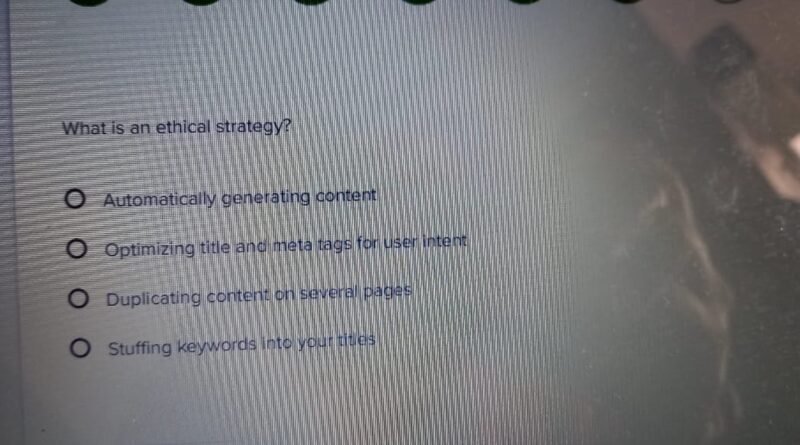What Is An Ethical Strategy
Ethical strategy is the process of designing and implementing an effective ethical framework that informs all your business decisions. It’s not a one-time event, and it’s not something you can set and forget about. Rather, it’s a continuous effort that should be revisited on a regular basis. A responsible ethical strategy has three key components: values, goals, and actions. Values provide the foundation for our ethical decision-making, while goals help us measure progress and ensure that our actions are aligned with our values. Actions are the most important part of an ethical strategy—they’re what we take to make the world a better place. In this blog post, we will explore each of these elements in more detail and show you how to create an ethical strategy for your business.
What is an ethical strategy?
Ethical strategies are a way to make ethical decisions in your work or personal life. They can help you think about what is right and wrong, and how to act on those thoughts.
There are different ways to approach ethics, but the most common is called the “4 P’s” framework: Principle, Practice, Proportionality, and Praxis. This framework helps you think about how you should act in each situation.
You can also use the “3 Rs” model: Righteousness, Responsibility, and Reparation. This model helps you think about what you need to do to be ethical in each situation.
Elements of an ethical strategy
The first step in any ethical strategy is to identify the problem. Once you know what the problem is, you can begin to develop solutions. If you’ve done your research, you may have come up with a list of potential solutions. However, before you can choose a solution, you need to determine if it is ethical. To do this, you will need to consider four elements:
1) Scope
What does the solution affect? What are the consequences of implementing the solution?
2) Impact
How will implementing the solution change things? Will it improve conditions or worsen them? How will people respond once the change goes into effect?
3) Benefit
Does implementing the solution create more benefits than harms? Is there a net benefit for society as a whole? For individuals within that society?
4) No Harm Principle
If there is potential for harm, should the solution be implemented regardless of its benefits?
Types of ethical strategies
There are a few different types of ethical strategies that businesses can use to align their interests with those of their stakeholders.
The first type is the paternalistic strategy, which involves the company acting like a benevolent parent and protecting its customers from harm. This approach can be effective when customers trust the company to make smart decisions for them and when the company has enough power to impose its will on competitors.
The second type is the contractual strategy, in which companies agree to abide by certain rules or guidelines in order to curry favor with their stakeholders. For example, a business might promise not to compete unfairly with its suppliers, or it might pledge to treat employees fairly.
The third type is the stakeholder management strategy, which involves managing conflicting interests among various groups of stakeholders. For example, a business might negotiate deals with suppliers in order to get better terms for itself, but it might also work hard to maintain good relationships with its customers and employees.
Each of these types of ethical strategies has its own advantages and disadvantages. The most successful businesses typically use multiple strategies simultaneously in order to best protect their interests while satisfying their stakeholders as well.
Ethical considerations in business
An ethical strategy is a process of identifying and addressing the ethical concerns that may arise in a business setting. The goal of an ethical strategy is to ensure that the business practices it engages in are consistent with its values and principles, and that any potential conflicts of interest are managed responsibly.
When developing an ethical strategy, businesses should consider their core values and principles. These values might include integrity, honesty, accountability, compassion, or fairness. Principles might include the principles of sustainable development or equal opportunity.
Once businesses have identified their core values and principles, they should start to ask themselves what behaviors fall within those boundaries. For example, a company with a principle of sustainability might not be comfortable engaging in activities such as mining or manufacturing products that produce environmental damage. Similarly, a company that believes in equality for all employees may not be comfortable awarding preferential treatment to certain groups (such as senior executives).
Once businesses have established which behaviors fall within their boundaries, they need to decide how to address potential conflicts of interest. For example, a company selling products that could potentially harm the environment might want to avoid any conflict of interest where its own interests might be at stake (such as owning stock in a company whose products could impact the environment). Alternatively, a company selling health-related products might want to avoid any conflict of interest that could compromise its impartiality (for example, being on the board of directors for a rival health care provider).
Finally, ethical strategies should be revisited
Conclusion
Ethical strategies are a type of planning that helps us make choices that are both effective and ethical. By considering the consequences of our actions, we can create plans that will help us to achieve our desired outcomes while still upholding our values. Armed with this knowledge, it is now easier than ever to be an ethical leader in your field.
FAQ
What Is An Ethical Strategy
Automatically generating content
Optimizing title and meta tags for user internet
Duplicating content on several pages
Stuffing keywords into titles
Ans: Optimizing title and meta tags for user internet

